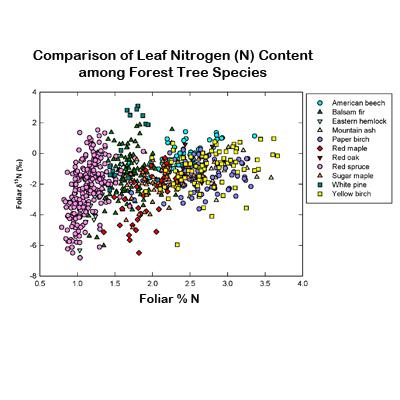Regional Assessment of N Saturation Using Foliar δ15N Natural Abundance in Foliage: Network Development and Foliar δ15N, Soil C:N, Net Nitrification Synthesis, Species Patterns, Soil δ1

Nitrogen saturation (point when an ecosystem cannot use or store any more nitrogen) induced by atmospheric nitrogen deposition can have serious consequences for forest health in the Northern Forest and other regions. Developing indicators for determining whether a forest is at or nearing nitrogen saturation would contribute to forest management and better understanding of nitrogen cycling in forest ecosystems.
NSRC researchers evaluated the δ15N isotope of nitrogen (a measure of naturally occurring forms of nitrogen which has been used to evaluate nitrogen cycling) in tree foliage to determine if it would be a strong, regional-scale measure of the onset of nitrogen saturation in forest ecosystems. Researchers assembled a large dataset on atmospheric nitrogen deposition, foliar and root δ15N and nitrogen (N) concentration, soil carbon to nitrogen ratios, and mineralization and nitrification. Data originated from sites in northeastern North America, Colorado, Alaska, Chile, and Europe.
Local drivers of nitrogen cycling (nitrification, mineralization, and forest floor and soil carbon to nitrogen ratios) were more closely related to foliar δ15N than was regional nitrogen deposition. Foliar N concentration was more strongly correlated with nitrogen deposition, but foliar δ15N was more strongly related to nitrification. Levels of foliar δ15N decreased across the following tree species: American beech > yellow birch > sugar maple. Species composition, land-use history, and climate also affected foliar δ15N. Relationships between foliar δ15N and soil variables were stronger when analyzed on a tree species by species basis than when many species were lumped. Examining δ15N values of foliage may improve our understanding of how forests respond to cascading effects of nitrogen deposition.
